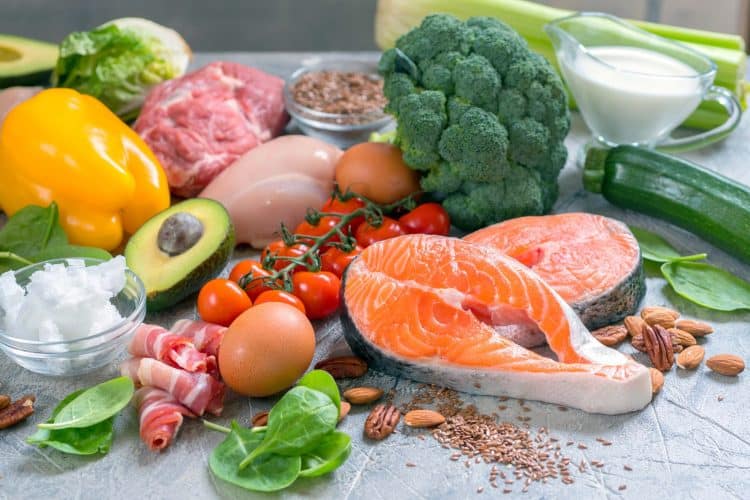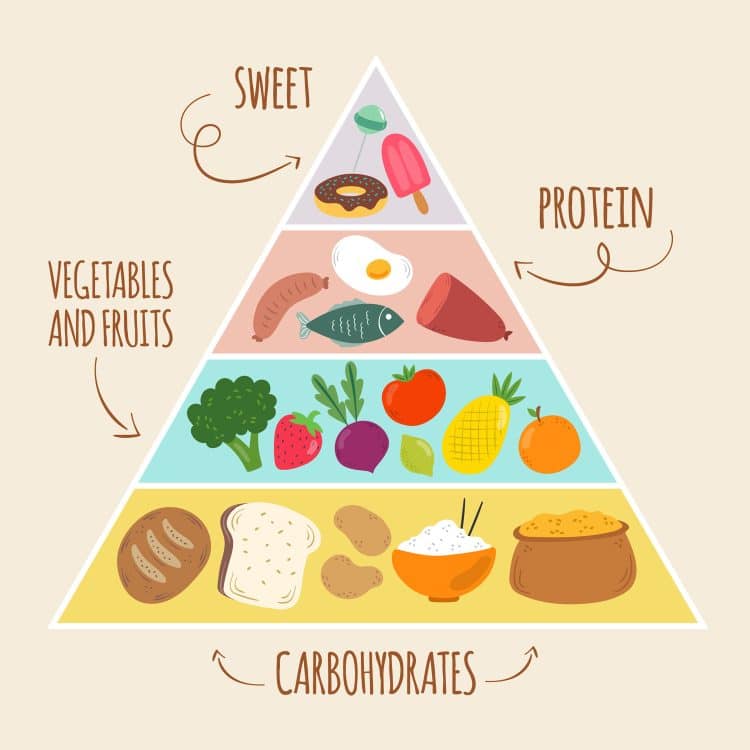I’ve been studying diet and nutrition since I was in school. Initially, my interest came from a desire to improve my athletic performance. However, as fitness and exercise became my chosen career path, I wanted to learn more so I could help my clients achieve their weight loss and health goals.
This is a big part of my job, especially as studies published on PubMed suggest that close to 50% of adults are currently overweight or obese (1).
Over the last 30+ years in the fitness industry, I’ve learned a lot about diet and nutrition. My biggest “discovery” is that there is no one-size-fits-all diet that’s perfect for everyone. We all have different nutritional needs and wants. As such, what works for one person may not work for another.
Because of this, I’ve made it my mission to become familiar with as many different diet programs as possible. Some have proven to be nothing short of dangerous or ineffective fads. In contrast, others are powerful tools that can help improve body composition, energy, and health.
In this article, I’m going to discuss metabolic diets so you can determine if they are the right type of eating plan for you.
What Are Metabolic Diets?
Metabolic diets are eating plans that optimize your metabolism or metabolic rate. A fast metabolism could help you lose weight faster by increasing daily caloric expenditure. In contrast, a slower metabolism makes weight loss more challenging. Therefore, any metabolism-boosting diet could be beneficial.
Level Up Your Fitness: Join our 💪 strong community in Fitness Volt Newsletter. Get daily inspiration, expert-backed workouts, nutrition tips, the latest in strength sports, and the support you need to reach your goals. Subscribe for free!
But what IS your metabolism?
Simply put, your metabolism is the total energy your body uses in 24 hours, typically expressed in calories. Your metabolism comprises several components, including:
- Basal Metabolic Rate (BMR): This is the number of calories your body uses to maintain its essential functions, including breathing and circulation while at rest. Metabolic diets aim to affect your BMR.
- Thermic Effect of Food (TEF): This is the energy your body uses to digest, absorb, utilize, and store food. TEF is another of the components of energy expenditure that metabolic diets affect.
- Thermal Effect of Activity (TEA): This is the energy used during purposeful physical activity, such as exercise and sports.
- Non-Exercise Physical Activity (NEPA): This includes the calories burned during incidental physical activities that are not considered exercise. Examples include walking for transport or doing household chores. This is also known as NEAT, short for non-exercise activity thermogenesis.
- Total Daily Energy Expenditure (TDEE): TDEE is the total of all the other metabolic components. It is the number of calories your body uses in 24 hours, including what’s used during exercise, digesting food, fidgeting, and rest.
Unfortunately, things like advancing age, sedentarism, metabolic disorders, insulin resistance, etc., can lower your metabolism and make it harder to lose weight. Metabolic diets aim to “take the brakes off” and optimize your metabolism
A faster metabolism means you’ll burn more calories per day, which could help with weight loss. You’ll still need to reduce your food intake to create a caloric deficit (2). However, burning more calories per day means that you may not need to lower your food intake so aggressively or do as much exercise.
Types of Metabolic Diet
There are several different types of metabolic diets. These include:
- Low-Carb Diet
- The Zone Diet
- The Paleo Diet
- High Protein Diet
- Ketogenic Diet
- Atkins Diet
- South Beach Diet
- Intermittent Fasting Diet
- The Metabolic Typing Diet
As well as creating that all-important calorie deficit, these eating plans are designed to “rev up” your metabolic rate and increase your energy expenditure. Some do it by altering your macro ratios, while others do it by including metabolism-boosting foods. However, the end goal is the same – to burn more calories per day without doing more exercise.
How Do Metabolic Diets Work?
First, I must stress again that weight loss depends on creating an energy deficit. This means you need to consume fewer calories than your body needs to maintain your current weight.
For example, if you currently consume 2,250 calories per day and your weight is stable, you are probably in an energy balance. In other words, your calorie intake is equal to your calorie expenditure.
Therefore, to lose weight, you need to eat less (or move/exercise more). Focusing on your diet, consuming 1,750 calories will give you a daily deficit of 500 calories. Assuming that a pound of fat equals 3,500 calories, this will result in a one-pound weight loss per week.
Metabolic diets increase your energy expenditure without increasing your activity levels or decreasing your food intake further. Thinking of your body as a car, a metabolic diet revs up your engine, so you burn more fuel, even when your vehicle is stationary.
They achieve this in several ways:
Macronutrient Ratios
Earlier, I told you how eating, digesting, absorbing, utilizing, and storing food uses energy. This is called the thermal effect of food, or TEF for short. TEF varies between macronutrients or food groups. Therefore, choosing foods with a higher TEF means your body will use more calories to process what you have eaten.
Fat: Dietary fats have a TEF of 0-3% (3). This means they have a very small effect on your metabolism. As such, your body uses only a small amount of energy to digest and utilize fats. This, along with their high-calorie concentration, helps explain why low-fat diets are popular for weight loss.
Carbohydrates: The TEF for carbs is 5-10% (3). While higher than fats, this is still quite low. Foods made from refined ingredients that are low in fiber tend to have a lower TEF than natural, high-fiber foods. For this reason, most dieters should limit their intake of processed and junk food.
Protein: At 20-30%, the TEF for protein is considerably higher than fat or carbohydrate. As such, it is the cornerstone of many metabolic diets. Eating protein not only revs up your metabolism, but it’s also more filling than carbs, less likely to be converted into body fat, and helps preserve muscle mass. Find your daily protein intake here.
Most metabolic diets emphasize protein. This may mean basing all main meals and snacks on protein, such as a high-protein diet. In contrast, very low-carb diets, such as Atkins and keto, all but ban carbs. This means protein and fat are your main sources of energy.
Try our Macronutrient Calculator
Macronutrient Timing
With their different TEFs, you can consume the macros at certain times of the day to maximize your metabolism. Eating protein every few hours will keep your metabolic rate elevated, so you burn more calories per day. A high-protein breakfast is especially valuable.
In contrast, it’s best to consume carbohydrates shortly before and during the hours after exercise. This will ensure they mostly end up in your muscles and are taken away from your adipose tissue or fat cells.
According to most metabolic diets, it’s generally best to consume fats alongside protein and limit them when you consume lots of carbs. This is especially true for highly refined/processed foods. A high-fat/refined carb “fuel mix” is a recipe for fat storage.
Observing these timings allows you to harness the power of TEFs and use them to maximize your metabolic rate.
Thermogenic Foods
Protein isn’t the only food that increases your metabolic rate. Thermogenic foods are so-called because they increase thermogenesis or heat production, contributing to your metabolic rate.
Foods that are said to increase thermogenesis include:
- Black Pepper
- Black tea
- Broccoli
- Cardamom
- Cayenne
- Chili Peppers
- Cinnamon
- Coffee
- Cumin
- Dandelion
- Garlic
- Ginger
- Green Tea
- Guarana
- Jalapeño
- Kale
- Matcha
- Spinach
- Turmeric
The effect of these foods is quite small. However, when you add them to protein-rich foods such as chicken, turkey, fish, etc., you create a meal that could help boost your metabolism for easier weight loss.
Level Up Your Fitness: Join our 💪 strong community in Fitness Volt Newsletter. Get daily inspiration, expert-backed workouts, nutrition tips, the latest in strength sports, and the support you need to reach your goals. Subscribe for free!
There are also thermogenic or fat-burning supplements that contain blends of ingredients chosen for their metabolism-boosting effect. Unfortunately, most have a very weak effect.
Meal Frequency
Meal frequency refers to how many meals you eat per day. Some metabolic diets recommend dividing your calorie intake over several small meals, e.g., four to six instead of the more usual two to three.
Because of the thermic effect of food or TEF, eating increases your metabolic rate. Therefore, it’s often thought that smaller, more frequent meals are better for weight loss as they keep your metabolism elevated throughout the day. A study from the New England Journal of Medicine supports this point of view (5).
However, other studies suggest that increased meal frequency has little impact on metabolism (6). That said, eating smaller, more frequent meals can help stabilize energy and blood glucose levels, which may be advantageous even if there isn’t much impact on your metabolism.
Related: Find Calorie Breakdown Per Meal
Caloric Cycling
Long-term calorie restriction can cause a reduction in your metabolic rate (7). That’s the opposite of what you want, as a slower metabolism will hinder weight loss. Some metabolic diets attempt to overcome this problem with calorie cycling.
Calorie cycling, as the name suggests, involves alternating periods of low-calorie intake with higher-calorie intakes. For example:
- Monday – 1750 calories (500 below maintenance)
- Tuesday – 1750 calories (500 below maintenance)
- Wednesday – 2250 calories (maintenance)
- Thursday – 1500 calories (750 below maintenance)
- Friday – 1750 calories (500 below maintenance)
- Saturday – 2500 calories (250 above maintenance)
- Sunday – 1750 calories (500 below maintenance)
Such an approach is not supported by any studies. However, if prolonged undereating leads to a lower metabolic rate, it makes sense that occasional overeating may get your metabolism back on track. Cheat meals are another way to achieve this.
Effect on Blood Glucose and Insulin
Most metabolic diets aim to regulate your blood glucose and insulin levels. They do this by minimizing your consumption of fast-acting carbs, timing carb intake around physical activity, and emphasizing dietary proteins.
Stable blood glucose and, therefore, low insulin levels create a better environment for fat burning. That’s because insulin is a fat-storing hormone, and elevated levels impair fat burning. Some metabolic diets go so far as to monitor blood glucose levels and plan meals according to your results.
Stable blood glucose levels mean your energy levels and appetite will be more stable.
Related: The Anabolic Window – Fitness Myth or Training Truth?
Ketosis
Some metabolic diets, such as keto and the Atkins diet, severely limit your carbohydrate intake, often to 50 grams or less per day. After about a week, as you deplete your muscle and liver glycogen (carbohydrate stores), your body starts making an alternative energy source for your brain – ketones. We make ketones from fats.
The process of converting fats into ketones is not very efficient, and it takes a relatively large amount of fat to make a few ketones. This increases your metabolic rate and potential for fat loss. However, the metabolic shift of entering ketosis is not without side effects, and many low-carb dieters experience the “keto flu” until they are fully keto-adapted.
Symptoms of the keto flu include:
- Bad breath
- Constipation
- Dizziness
- Fatigue
- Headache
- Increased urination
- Irritability
- Muscle cramps
- Nausea
- Sugar cravings
- Sweating
Not all metabolic diets result in ketosis, but all ketogenic diets affect your metabolism. However, as ketosis comes with several side effects, some of which can be unpleasant, severe carbohydrate restriction is not for everyone.
Frequently Asked Questions
Do you have a question about metabolic diets for weight loss? No problem, because we’ve got the answers! Need more information? Feel free to reach out in the comments section at the end of this article, and we’ll get back to you ASAP.
1. Are metabolic diets suitable for everyone?
This is a tricky question to answer because there are several different metabolic diets. For example, very low-carb ketogenic diets are not recommended for everyone, as they come with certain side effects. In contrast, eating protein at every meal while avoiding refined carbs is a safe approach for most dieters.
If you are in any doubt, begin with a less extreme metabolic diet, such as The Zone, or a high-protein diet. Only progress to a ketogenic diet if you have no contraindications to very low-carb eating plans.
2. Which is the best metabolic diet for weight loss?
As I said at the beginning of this article, there is no one-size-fits-all diet that’s perfect for everyone. We all have different food preferences and respond to diets according to our unique genetics. Some people can eat a lot of carbs while continuing to lose weight, while others are far less carb-tolerant and do much better on a low-carbohydrate diet.
This means that the best metabolic diet for weight loss is the one that works for you and that you can stick to. Not for a week or a month, but for as long as it takes to reach your goal weight.
With that in mind, you’ll probably need to experiment with a few different metabolic-type diets until you find the one you like the best.
3. Can I work out on a metabolic diet?
While you can lose weight without exercising, it’s generally easier if you incorporate regular workouts into your schedule. Exercising burns calories, saving you from having to starve yourself slim.
That said, low-carb metabolic diets can leave you feeling tired and weak, especially during the first week or so. This is when your body adapts to using ketones for fuel. You may benefit from easier workouts or a deload week during this time. You can return to your regular exercise routine when you are ketone-adapted.
However, it’s also worth noting that exercise depletes muscle and liver glycogen. As such, it could help get you into ketosis sooner.
4. How sustainable is a metabolic diet in the long term?
Diets that “ban” certain foods or food groups are usually harder to stick to than more conservative eating plans. For example, it’s not too difficult to eat more protein and boost your metabolism with the increased TEF of that food group. In contrast, giving up bread, rice, pasta, potatoes, cereal, etc., as you must for keto, is often much harder.
So, consider your metabolic diet options, and go for the one that best matches your food preferences and lifestyle. If you can’t live without bread and pasta, keto is not the diet for you. But if you love eating meat, nuts, fish, dairy, etc., you’ll probably thrive without carbs.
5. How fast can I lose weight on a metabolic diet?
Weight loss can be pretty rapid on some metabolic diets, especially the ketogenic ones. That’s because as you use and lose glycogen, you also lose water. Subsequently, some keto dieters lose ten pounds or more in the first 14 days of a very low-carb diet.
It’s important to stress that most of this weight is water, but some dieters find these rapid results motivating. However, such quick weight loss is unsustainable and will slow to 1-2 pounds per week after that.
Non-keto metabolic dieters should expect to lose 1-2 pounds per week. This is considered a safe and sustainable rate of weight loss.
Closing Thoughts
All diets are metabolic as they affect your metabolism. However, some diets specifically maximize your metabolism for easier, faster weight loss. Most do this by increasing your intake of protein, moderating your blood glucose and insulin levels, and maximizing thermogenesis.
However, while these are all tried and true effects of metabolic diets, they are not the most crucial weight loss consideration. In fact, you should view them as the icing on the weight loss cake. That’s because creating a calorie deficit is the most critical weight loss factor (8).
So, feel free to try a metabolic diet, but don’t overestimate how effective it will be. The cornerstone of any successful weight loss effort is eating fewer calories than your body needs. Faced with this energy shortfall, your body will have no option but to burn fat for fuel, and that’s the key to successful weight loss.
Learn More:
- Metabolic Training for Fitness and Faster Fat Loss
- The Metabolic Confusion Diet
- Utilize Metcon (Metabolic Conditioning) Training To Your Advantage
- Metabolic Typing Diet Approach: How To Eat Right For Your Type
- Find Your Resting Metabolic Rate
- Common Exercise and Nutrition Science Terms Explained!
References:
- National Institute of Diabetes and Digestive and Kidney Diseases. (2023, September 21). Overweight & Obesity Statistics. https://www.niddk.nih.gov/health-information/health-statistics/overweight-obesity
- Strasser B, Spreitzer A, Haber P. Fat loss depends on energy deficit only, independently of the method for weight loss. Ann Nutr Metab. 2007;51(5):428-32. doi: 10.1159/000111162. Epub 2007 Nov 20. PMID: 18025815.
- Tappy L. Thermic effect of food and sympathetic nervous system activity in humans. Reprod Nutr Dev. 1996;36(4):391-7. doi: 10.1051/rnd:19960405. PMID: 8878356.
- Westerterp-Plantenga M, Diepvens K, Joosen AM, Bérubé-Parent S, Tremblay A. Metabolic effects of spices, teas, and caffeine. Physiol Behav. 2006 Aug 30;89(1):85-91. doi: 10.1016/j.physbeh.2006.01.027. Epub 2006 Mar 30. PMID: 16580033.
- Jenkins DJA, Wolever T, Vuksan V, Brighenti F, Cunnane S, Venketeshwer Rao A, Jenkins A, Buckley G, Patten R, Singer W, Corey P, Josse R. Nibbling versus gorging: metabolic advantages of increased meal frequency. N Engl J Med. 1989 Oct 5;321(14):929-34. doi: 10.1056/NEJM198910053211403.
- Leidy H, Campbell W. The effect of eating frequency on appetite control and food intake: a brief synopsis of controlled feeding studies. J Nutr. DOI: 10.3945/jn.109.114389.
- Fontana L, Klein S, Holloszy JO, Premachandra BN. Effect of long-term calorie restriction with adequate protein and micronutrients on thyroid hormones. J Clin Endocrinol Metab. 2006 Aug;91(8):3232-5. doi: 10.1210/jc.2006-0328. Epub 2006 May 23. PMID: 16720655.
- Freire R. Scientific evidence of diets for weight loss: Different macronutrient composition, intermittent fasting, and popular diets. Nutrition. 2020 Jan;69:110549. doi: 10.1016/j.nut.2019.07.001. Epub 2019 Jul 4. PMID: 31525701.











